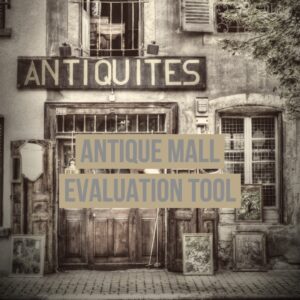Being a dealer at an antique mall can be rewarding personally, professionally, and financially. I can testify to that statement because having an antique booth has allowed me to fulfill so many of my dreams such as doing creative work and fostering my entrepreneurial spirit. I encourage people every day to try it for themselves. I am well aware though, that not everyone who dabbles in the antique business experiences the same successes. It saddens me to see other dealers who struggle with common, avoidable antique booth mistakes.
It saddens me to see other dealers who struggle with common, avoidable antique booth mistakes.
I would love to be able to help someone out there by sharing what I’ve learned from twenty years as a retail executive and corporate trainer, as well as being an antiques dealer for several years. If you already have an antique booth and you are struggling to make money, or if you are considering becoming a dealer and you want to set yourself up for success from day one, this post is for you. Here is my list of the top ten mistakes people make with their antique booths.
1. Over or underpricing
Have you have ever picked up an item you are interested in purchasing, looked at the price, and made an instant judgment about the rest of the store?
“Whew, these prices are way too high.”
“The price is so low, this piece must not be an original. It has to be a reproduction.”
I know I have had those thoughts! Most customers decide if they will shop an antique booth by looking at the prices of just one or two items. This is why it is so important not to over or underprice your items. Overpricing means you may turn customers away. Underpricing means you may underrepresent the value of your items- which also turns customers away and hurts your profitability.
Do not simply price your items based on similar items listed on eBay- there are many more factors to consider. Your item may be in better or worse condition. Your local market may not have the same demand for that item (keep in mind that eBay draws consumers from around the globe). Use your best judgment, research, and sales experience to offer a reasonable price that will make you and your customers happy.
Need Help Determining the Value of Antiques?
Get my free guide to learn the methods and resources I use to determine the value of antique and vintage items
2. Discounting your entire antique booth
I walk past these kinds of signs every time I visit an antique mall, “Entire booth 25% off” or “Everything 50% off.” Let me be clear, unless a dealer is going out of business or clearing out all merchandise to make room for new inventory, discounting the entire antique booth is never a good sales strategy. Don’t get me wrong, doing this may result in immediate sales. But immediate sales don’t equal profits, customers, or future longevity. Consider some of the big-box retail stores where you shop. Does Target frequently discount their entire store? Or do they reduce the price of certain items that haven’t sold within a period of time? How often does Louis Vuitton introduce a new bag at a 25% discount? As a small business retailer, you can learn a lot about markdowns by observing when and how the pros do it.
As a small business retailer, you can learn a lot about markdowns by observing when and how the pros do it.
3. Same old, same old
Your regular customers are hoping to see something new and enticing every time they shop in your antique booth. It is so important to rotate your items around to give them a new context, and to restock your antique booth regularly with fresh merchandise. If you want to keep your customers coming back, treat them to a new experience each time they do. Variety is the spice of life!
4. Lack of selection and few price points
I am thinking of a few different antique booths in my mall-- one sells baseball cards, another vinyl records, and the last one has 4-5 large pieces of furniture. Each of these booths look great- and I’m happy that they are a part of my mall because they bring in a certain "niche" group of customers. The problem is that the majority of our customers do not collect baseball cards. Or records. Or armoires. I honestly do not know how these dealers stay in business. Perhaps for them, it is just a hobby. For me, it is not- I want and need to make money- and that means selling a large quantity of items.
I want every customer to stop and shop in my antique booth- so I understand that I need to offer a wide variety of merchandise. If you want to make money, bring in a selection of items that appeal to a diverse group of people. Have some items that are small and inexpensive, as well as other large items that will bring in big dollars. Offer something for everyone.
5. Poor item placement
I walked into an antique booth recently and almost tripped over a set of crystal stemware that was on the floor. I’m guessing the dealer ran out of table space- or maybe a table had recently sold- and they didn’t have a better place for them. Regardless of the reason- these beautiful, delicate pieces of glass clearly did not belong on the floor.
Carefully placing items where they ‘belong’ and creating appealing and attractive displays speaks volumes about your brand. In fact, some items have a better chance of selling based solely on where you place them within your booth.
Some items have a better chance of selling based solely on where you place them within your booth.
6. Dealin’ dirty
Of course, I’m sitting here humming Chamillionaire’s “Ridin’ Dirty” as I expand on this thought. There are countless antique booths out there “dealin’ dirty.” I am talking about grungy, dusty, smelly, and sometimes even buggy. I picked up a milk-glass mug recently that had a little bonus inside- a dead fly. Oh my goodness. This is a cry for help going out to antique dealers everywhere. Clean your booth, please.
7. Your antique booth is Alcatraz
Have you ever been to Alcatraz Island? Alcatraz was a maximum security prison on a small island off the coast of San Francisco. It was nearly impossible to get in and out of there- except for a few famous men who escaped. Some antique booths out there are like Alcatraz. It is impossible to get to any of their merchandise because it is all behind locks and bars.
I see the same scenario over and over again- customers standing in front of locked glass cases- trying to decide if they like an item enough to walk all the way to the checkout counter at the front of the mall to ask for an employee who might have the key. Most will not.
I understand the risk of theft and damage. I also understand the difference between museums and stores. As dealers, we must be strategic in deciding whether to lock or not lock something up. I would suggest that at least a few of your items escape from Alcatraz!

8. Expenses exceed earnings
How long can you possibly stay in business if you are losing money every pay period? Consider some of your biggest expenses: rent, inventory, marketing, etc. Develop a plan to control some of these expenses. For example, rent the smallest space that fits your needs, and do not expand to future booths until your sales can justify the cost. Be prudent in purchasing (and bargaining for) inventory, and strategic in marking it down when necessary in order to turn it over quickly. In a nutshell, we must sell more than we spend. Expense control is an essential skill for an antique booth business owner.
Expense control is an essential skill for an antique booth business owner
9. Working harder, but not smarter
Many dealers work in their booths every single day, yet their sales do not reflect their extra time and work. I work in my booths one day a week. I have found that I am able to accomplish everything that I need to do within that one day. Sure, if I was there every day, I might have a few more conversations with customers, and my antique booth might stay a little neater, but if I were to factor in the cost of my labor hours and gasoline to and from the mall, it would mean less overall profit for my business. Instead of spending more time at the mall, I carefully plan out the time that I do have. I make a to-do-list, and I check it twice. Just like Santa Claus.
10. Giving up too quickly
It is almost inevitable- at some point within your first three months, you’ll probably feel like quitting. Especially if you have made some of the aforementioned mistakes. Just remember, you are not alone. This business takes practice. You will have highs and lows- accompanied by big and small paychecks. I remember doing a ‘happy-dance’ my first month and hanging my head in shame my second. Hang in there. You will learn what sells and what doesn’t. You will pick up better ways of merchandising and get a better feel for pricing and markdowns. You’ve got this. I’ve been there, done that, and I have lived to tell the tale. YOU can, too!

Don't make the mistake of picking the wrong antique mall!
Get the Free Antique Mall Evaluation Tool to help you choose the right mall for your antique booth business.

